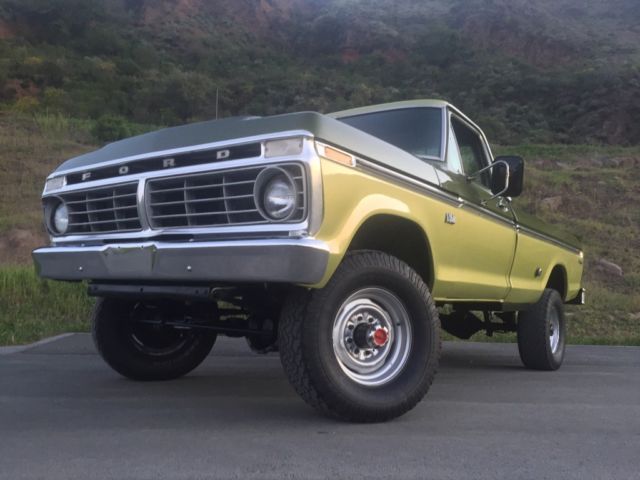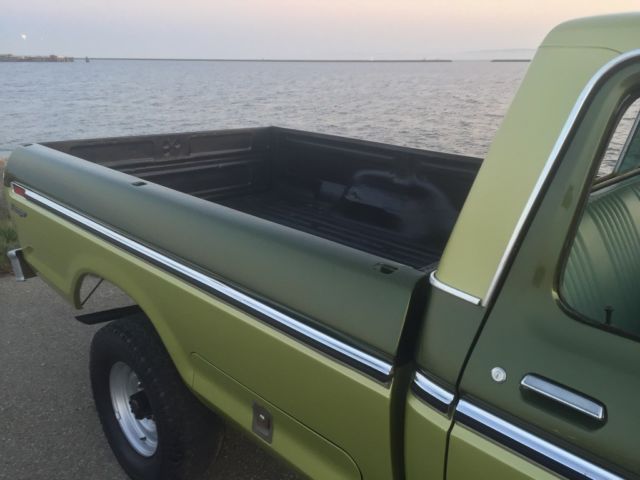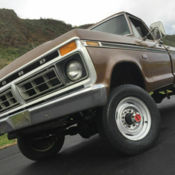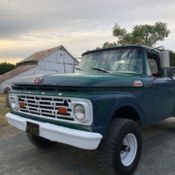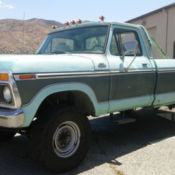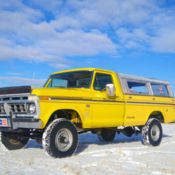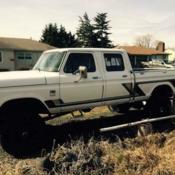1975 Ford F250 Highboy 4wd Very Rare "DSO-code" California Barn Find No Reserve
1975 Ford F-250 Ranger
1975 FORD F-250 4-WHEEL DRIVE
"HIGHBOY" RANGER
VERY RARE "DSO CODE"
(DISTRICT SALES OFFICE)
SPECIAL FACTORY ORDERED GLAMOUR GLOW PAINT
"California Barn Find"
~Very Rare #F-26 4x4 Ranger
~ Special factory ordered built in San Jose California
~Lifelong California Resident
Medium Green Glow Glamour over Hatteras Green Metallic
~Sold 43 years ago in Lafayette California
~Copy of Original MSRP
~Once in a lifetime time capsule that cannot be duplicated
NO RESERVE AUCTION BID TO WIN
Up for bid is a unique opportunity to buy an original 1975 Ford F250 4 wheel drive 3/4 ton pickup Highboy pickup that would be nearly impossible to duplicate and is possibly a one of a kind.
MSRP
F262 133 CUSTOM STYLESIDE PICKUP WITH 4X4 OPTION
MED GREEN GLOW GLAMOUR PAINT WITH HATTERAS GREEN METALLIC
REGULAR AND DELUXE TUTONE
7700 GVW PACKAGE
ENGINE 360 V8
RANGER PACKAGE
AMMETER - OIL GUAGE AND FUEL ECOM LT
EMISSIONS SYSTEM-CONTROL PKG
TOOL STORAGE BOX
AXLE RR 5300 DANA 60 LIMITED SLIP
POWER STEERING
AXLE FR 3550 DANA 6CF-HD
LH-RH SWING MIRRORS
RADIO AM
SLIDING REAR WINDOW
REDUCED SOUND LEVEL EXHAUST
SUPER COOLING PACKAGE
VIN: F26 Y R XO2812
F26= 1973-1979 4WHEEL DRIVE F250
Y= 360 V8
R= SAN JOSE CALIFORNIA
X02812= SEQUENTIAL PRODUCTION NUMBER 5/75 BUILT
WB = 133
A= NEW PROCESS 435 MANUAL 4 SPEED
F-262= 73-79 F250 4 WD PU
AXLE= #B4P
B4= 4.10 DANA 9SPICER) MODEL 60 LIMITED SLIP
P=4.55 RATIO DANA SPICER MODEL 60F WITH POWER STEERING
In the collector car market value is all about supply and demand and rare vehicles that were built in limited supply are rare because fewer were built. Vintage 4 wheel drive classics were limited to a need basis were conditions required 4wd for snow and ice or an overall harsher enviromenthowever places like sunny California 43 years ago people simply did not buy 4x4 trucks as they do today where a 4x4 truck is the norm the best example of supply affecting demand for vintage 4x4s are the 1966-1977 Ford Broncos or the old Toyota FJ40s which have skyrocketed in value in the last few years. The demand has gone up as the supply has dwindled. People in places like Wyoming or Michigan bought them for a purpose and over time used them up.
The next collector boom is going to be vintage 4x4 trucks accordingto Fortune magazineand Hagerty Insurance the largest collector car Insurance company in the nation who has a vested interest in collector car trends and have said the 1973-1979 Ford F series trucks are on the way up the most valuable being the more limited production 4x4 models.
They made a lot of Ford F series trucks in those years and has been the number one selling vehicle in the country for decades however the majority being the 2 wheel drive model 1/2 tons which account for about 82% of the F series sales in comparisonthe much heavier duty F-250 3/4 tons were sold as work trucks and fewer were built with only 18% of the F-series production being 4x4s and in 1975 when increased fuel cost was an issue for all auto sales in America the majority of heavy duty 4 wheel drive trucks were sold by dealers for use in areas where 4WD was needed for snow and rough terrain and even though many were built in California for the entireWestern region most were shipped to places like Montana or Idaho and 4 decades plus later most of those were used up and are long gone or riddled with rust from exposure to salted roads and years of heavy duty use.
This 1975 Ranger "Highboy" is a true California survivor having been a loaded up special ordered "DSO Code" direct from the (District Sales office #72) at the San Jose California factory from Don Young Ford in Lafayette California just 30 miles to the North. The one thing for sure few Highboys were made like this Ranger and common sense would dictateeven fewer 4 decades later stillexist
(Other special order vehicles that were DSO codes built in San Jose same are the original Mustangs Fastbacks that were shipped from San Jose south to the Shelby factory at LAX in Southern California)
This dealership in Lafayette was a small low volume Ford dealership in a upscale community 20 min east of San Francisco. The 1970's was an era where small dealerships in expensive areas relied on high profit items to offset the lower sales volumes (and this was about as expensive of a pickup that was available at the time) and in 1975 when many people were shifting to more fuel efficientimport vehicles it would not be uncommon to see a top of the line Mustang convertible in a rare color like medium green glamour glow or yellow green metallic but quite unusual for a heavy duty truck which was designed to bring the people in by having something special or unusual on the show room floor.
Ironically this truck never made to the showroom and was dealer traded to a dealer across the bay in Burlingame California and has spent the last 43 years in one of the most expensive zip codes in the Golden State Hillsborough California at the time home to people like Bing Crosby and Shirley Temple Black not a typical demographic in 1975 for a 3/4 ton 4 wheel drive pickup.
It was built and sold in the San Francisco Bay Area and has never left.
This is a once in a lifetime opportunity that you or I can not duplicate
This is possibly one of a kind
1975 Ford F250 4x4 Ranger "Highboy" - YouTube
Video will open in a new window
What is a "Highboy"
Highboy: 1967-1977.5 Ford F-250 4x4 Regular Cab or Crew Cab light-duty
pickup truck with a divorced transfer case and narrow frame.
The Highboy got its name from sitting higher from the factory than other
Ford pick-up trucks. The divorced transfer case (Dana 24, NP203, or NP205)
caused the front-end to be higher, so the rear-end had 4-inch lift blocks
to bring the rear-end up to the same height. Once Ford switched to married
transfer cases in mid-1977, people started referring to the 1973-1977.5
divorced transfer case trucks as Highboys and the 1977.5-1979 married
transfer case trucks as Lowboys. The previous generation, 1967-1972, was
essentially the same, and has been included in most definitions of
Highboy as well.
################################################## #########################
# Highboy Axles #
################################################## #########################
Front axles were an 8-lug low-pinion Dana 44 (1967-1977.5), 8-lug
low-pinion Dana 44HD (1969-1975), or 8-lug low-pinion Dana 60 (1973-1975,
Crew Cab Highboys only). There were no high-pinion front axles in
Highboys, although high-pinion front axles are preferable to low-pinion
front axles. The Highboy front axles were a closed-knuckle design from
1967-1975, and open-knuckle design in 1976-1977.5. The open-knuckle
design is preferable. Many Highboy owners replace their low-pinion front
axles with a high pinion 1977.5-1979 Dana 44, or better yet, the 1979
high-pinion HD Dana 60 with 35-spline inner shafts and 30-spline outer
shafts.
Rear axles were an 8-lug full-floating Dana 60 with 16 splines (1967-1975)
or 30 splines (1967-1977.5), but both were the same 1-5/16" diameter. It
is common for those with the 16-spline Dana 60's to replace them with a
Dana 70, GM 10.5" 14-bolt, or other rear-end.
In 1976, HD external hubs became standard.
All Highboys had 4.10:1 gear ratios.
################################################## #########################
# Highboy Body #
################################################## #########################
The body sheetmetal became thinner in 1973, when the F-series began its
sixth generation (1973-1979). The fifth generation (1967-1972) became
known as bumpsides, and the sixth generation became known as dentsides.
Even though the sheetmetal is thinner on a dentside, Ford put a corrosion-
resistant coating on it and used more galvanized metal. Bumpsides
typically have rusted-out inner fenders and core supports, compared to
dentsides.
################################################## #########################
# Highboy Brakes #
################################################## #########################
Highboys had drum brakes on all wheels (1967-1975), or a combination of
front disc brakes and rear drum brakes (1976-1977.5). Highboys had either
manual brakes (1967-1977.5) or optional power brakes (1973-1977.5).
################################################## #########################
# Highboy Cabs #
################################################## #########################
All Highboys were Regular Cab or Crew Cab. There were no F-250 4x4
SuperCabs until 1978, possibly because SuperCabs don't bolt to the narrow
frame. Because of the narrow frame rails, a Highboy's rear cab mounts are
outside of the frame rails.
################################################## #########################
# Highboy Engines #
################################################## #########################
Here is a list of Highboy engines by year (1V indicates 1-barrel carb.):
1967: 240 1V Six, 300 1V Six, 352 2V V-8
1968-1972: 240 1V Six, 300 1V Six, 360 2V V-8
1973-1976: 300 1V Six, 360 2V V-8
1977: 300 1V Six, 351M 2V V-8, 400 2V V-8
Here is a list of Highboy engines:
240 1V Six (1967-1974)
300 1V Six (1967-1977.5)
351M 2V V-8 (1977)
352 2V V-8 (1967)
360 2V V-8 (1968-1976)
400 2V V-8 (1977)
Two modifications are common. First, the 360 is identical to the 390,
with the exception of the rotating assembly. Although 390's were never
offered in Highboys, many owners with 360's replace the rotating assembly,
converting to a 390, or sometimes to a 410. The other common modification
is to replace the factory engine with a 460, which was never offered in
Highboys.
################################################## #########################
# Highboy Frames #
################################################## #########################
Highboys have a unique frame, not shared with other trucks. Like the F-350
frame, all Highboys have a narrow frame, which is 33.5-inches wide. Fifth
generation (1967-1972) F-series trucks had narrow frames as well. Sixth
generation (1973-1979) F-series trucks had wider 37.5-inch rear frame
rails, except for the 1973-1977.5 Highboy frame and the 1973-1979 F-350
with 139-inch wheelbase. This frame rail width is measured directly
behind the rear bumper, from outside of rail to outside of rail. The F-350
frame was narrowed for duallies. The Highboy frame does not bend to the
left or right (unlike the other F-100, F-150, or F-250 frames), though it
does bend up and down to accommodate the cab. A front crossmember,
positioned just below the front bumper and visible while standing in front
of the truck, separates the Highboy frame from the bumpside F-350 frame.
No other truck had this crossmember. Since Highboys have a frame that is
different from other F-series trucks, Highboys require different beds than
other F-series. The Highboy frame was never used on another truck.
Ford frames have a stamped ID number on the right frame rail-outer-front,
near the engine crossmember.
The first digit is decade, where C=1960's and D=1970's.
The second digit is the year.
The third digit is T for Truck.
The fourth digit is Z, indicating a Ford part.
For example, C7TZ indicates a 1967 truck part.
Note: Ford updates part numbers, which is why the 131" wheelbase
1973-75's have a 1976 part number, and the 1976 150" wheelbase has a
1977 part number.
The following are listed below: Frame ID, height in inches of frame rail
just behind the cab, width of frame rail, thickness of rail, SM is
section modulus (one component of frame strength), WB is wheelbase,
years produced, model, and cab type (where CC is Crew Cab, RC is Regular
Cab, and SC is SuperCab):
The Highboy Regular Cab frame is the strongest for its wheelbase, tying
with some F-350's at SM=5.58, though it breaks the tie because it has an
additional crossmember that is not taken into account, as it shouldn't be,
when calculating section modulus. The Highboy Regular Cab frame is 28.8%
stronger than the Lowboy Regular Cab frame, and the Highboy Crew Cab frame
is 9.8% stronger than the Lowboy Crew Cab frame. The Lowboy SuperCab is
the strongest F-250 frame, and the F-350 Crew Cab has the strongest frame.
### Chrysler/GM Comparisons
1975 Dodge W200, 131 WB, 3.88 SM
1979 Chevrolet K20, 3.92 SM
There are no 1973-1979 Ford F-250 frames, whether 4x2 or 4x4, that are as
weak as the 1975 Dodge W200 131-inch wheelbase, or the 1979 Chevrolet K20.
################################################## #########################
# Highboy Gas Tanks #
################################################## #########################
Highboys came only with in-cab gas tanks, and optionally, with an
additional side-mounted gas tank, but never with a rear gas tank. A rear
gas tank is too wide to fit between the narrower 33.5-inch-wide rear frame
rails of the unique Highboy frame, and can only fit between the
37.5-inch-wide non-Highboy rear frame rails.
All F-series light-duty pickup trucks during 1956-1972 had in-cab gas
tanks. In 1973, Ford moved the gas tank to the rear under the bed, except
for Highboys. 1977 was the last year for the in-cab gas tank, because US
vehicle safety standards outlawed it. Make sure the filler neck grommet
remains completely sealed against the cab, and occupants will not smell
gas fumes. If both the cab and gas tank are breached in a serious
collision, the occupants probably will not be alive to worry about the
potential fire. In this respect, the gas tank is safer in the cab, since
it is less likely to be breached in the cab than under the bed, especially
while off-roading.
################################################## #########################
# Highboy Model Year Summary #
################################################## #########################
Highboys were manufactured from 1967-1977.5 (assembled before serial
number Y20,001). The last Highboy was produced in February, 1977. Below
is a summary of changes to Highboys by model year:
1967
The fifth generation F-series begins, and the Highboy is born. This is
the only year for the 352 2V V-8.
1968
The 360 2V V-8 replaces the 352 2V V-8 as the optional V-8. Regarding
seat belts, shoulder harnesses became an option.
1969
The low-pinion Dana 44 HD front axle was introduced.
1970
1971
This is the last year for the Ford Toploader 3-speed manual transmission
in the Highboy.
1972
This is the last year for the fifth generation F-series, and the 240 1V
Six (though it continued in other F-series trucks through 1974). The NP-435
4-speed manual transmission became the standard transmission, and for this
year only, the only transmission.
1973
The sixth generation F-series begins. Body sheetmetal becomes thinner,
the wheelbase changes, and the Highboy acquired the following new options:
SelectShift Cruise-O-Matic automatic transmission, power ram assist
steering, and power brakes. This is the last year for the Dana 24 transfer
case, and simultaneously, the first year for the (standard) NP205 part-time
and (optional) NP203 full-time divorced transfer cases. The 300 1V Six
replaces the 240 1V Six as the standard engine.
1974
1975
This is the last year for the low-pinion Dana 44 HD front axle, front
drum brakes, and closed knuckle axles.
1976
This is the last year for the optional 360 2V V-8. The Highboy gets front
disc brakes, open-knuckle axles, and standard HD external hubs. Many
assert that 1976 is the best year for a stock Highboy, because of disc
brakes, open-knuckles, HD hubs, and the FE engine.
1977
The 351M 2V V-8 and 400 2V V-8 engines replace the 360 2V V-8 as optional
V-8's. Highboy production ceased in February 1977, before serial number
Y20,001. Many assert that 1977 is the best year for a Highboy if the
intentions are to swap in a 460, because it has all the benefits of the
1976 year, and the 460 is easy to swap in as a replacement for the 351M or
400.
################################################## #########################
# Highboy Significance #
################################################## #########################
The Highboy is significant as the most desirable factory 4x4 of its era
due to its stout frame, increased height compared to other light-duty
pickup trucks, and divorced transfer case. Chrysler and GM did not have a
counterpart. The Highboy is also historically significant as the basis of
the first monster truck: Bigfoot 1.
################################################## #########################
# Highboy Steering #
################################################## #########################
Highboy steering was either manual (1967-1977.5) or optional power ram
assist (1973-1977.5). The power ram assist steering is problematic due to
its complexity with numerous hoses that get hit by road (or off-road)
debris, and the parts are now expensive and rare. There were two
different types of power ram assist steering on the Highboy: Garrison and
Bendix. Highboy steering, manual or optional power ram assist, is very
susceptible to bumpsteer. Many owners find it most desirable to convert to
crossover steering.
################################################## #########################
# Highboy Suspension #
################################################## #########################
Highboys had front leaf springs with 5-6 leafs (depending on GVW) that
were 3 inches wide. Highboy front leaf springs were more arched than
non-Highboy front leaf springs.
Highboys had progressive-type rear leaf springs with 9 leafs that were
2 1/4" wide, compared to non-Highboy rear leaf springs, which were 3 inches
wide. Highboy rear leaf springs were 48-inches eye to eye.
Many people refer to Highboys as trucks with a factory lift, which is
incorrect. Although Highboys were taller than other trucks, the suspension
was not lifted. The front suspension did not have a lift block, and was
taller to accommodate the divorced transfer case. The rear suspension had
a block between the axle and leaf springs to lift the rear of the truck,
but most trucks had a rear lift block, so it is incorrect to refer to
either Highboys or most trucks as factory lifted trucks.
################################################## #########################
Highboys came with tall, thin tires with an off-road tread. Many people
put larger tires on. A stock Highboy with its suspension in good
condition can handle 37-inch tall tires, as long as the tires are fairly
narrow, such as 12.5-inches wide, and the wheels have appropriate
back-spacing. Some people have managed 38-inch tall tires, although
usually, this is the point where suspension or body lift is required.
Highboy wheels were 8.00x16.5 inches, and are often replaced with 16-inch
wheels.
################################################## #########################
# Highboy Transfer Cases #
################################################## #########################
All Highboys had divorced transfer cases, as opposed to married transfer
cases. A married transfer case is bolted directly to the transmission. A
divorced transfer case is bolted onto its own cross-member, and is
separated from the transmission by a driveshaft. Highboys had Dana 24
part-time transfer cases from 1967-1973, and either the standard NP205
part-time or optional NP203 full-time transfer cases from 1973-1977.5.
The NP205 is the strongest and most desirable factory transfer case.
The Dana 24 is a cast-iron, gear-driven, part-time, 2-speed case with
1.86:1 gears. The NP203 is a chain-driven, full-time, 2-speed case with
2.00:1 gears. The NP205 is a cast-iron, gear-driven, part-time, 2-speed
case with 1.96:1 gears.
################################################## #########################
# Highboy Transmissions #
################################################## #########################
Highboys had either a 3-speed Ford Toploader manual (1967-1971), the
NP-435 4x2 4-speed manual (1967-1977.5 -- yes, the 4x4 got the 4x2
transmission), or the optional SelectShift Cruise-O-Matic C-6 in
1973-1977.5. The reason that 4x2 transmissions were used in these 4x4's
was due to the divorced transfer case. The NP-435 was optional in
1967-1971, and standard in 1972-1977.5.
Toploader Models (Engines): RAN-E1 (240 1V), RAN-G1 (240 1V), RAT-G
(300 1V, 360 2V), RAT-H (300 1V, 360 2V)
Toploader Gear Ratios (1,2,3,R): 2.99, 1.75, 1.00, 3.17
NP-435 Gear Ratios: (1,2,3,4,R): 6.69, 3.34, 1.79, 1.00, 8.00
Cruise-O-Matic Gear Ratios: (1,2,3,R): 2.46, 1.46, 1.00, 2.20
################################################## #########################
# Highboy VIN #
################################################## #########################
An example Highboy VIN is F26YRTxxxxx. F26 designates a F-250 4x4. All
Highboys begin with F26. The 'Y' indicates a 360 2V V-8 engine
(1968-1976), although other engines were offered, such as the 240 1V Six
(1967-1972), 300 1V Six (1967-1977.5), 351M 2V V-8 (1977), 352 2V V-8
(1967), and 400 2V V-8 (1977).
################################################## #########################
# Highboy Wheelbase #
################################################## #########################
The Highboy Regular Cab wheelbase changed from 131 inches in the fifth
generation (1967-1972) to 133 inches in the sixth generation (1973-1979)
F-series, and the Highboy Crew Cab was 150 inches in 1973-1979.
################################################## #########################
# Lowboy #
################################################## #########################
All F-250 4x4's after 1977.5 (specifically, beginning in March 1977) are
considered "Lowboys". Lowboys continued with the NP203 transfer case, and
could also have the NP205 transfer case, although from 1977.5-1979 it was
a married transfer case. Due to the married transfer case on the Lowboy,
the rear did not need the 4-inch lift block to match the front height. The
Lowboy used the wider F-250 frame, having 37.5-inch wide frame rails.
The Highboy Regular Cab frame is 28.8% stronger than the Lowboy Regular
Cab frame, and the Highboy Crew Cab frame is 9.8% stronger than the Lowboy
Crew Cab frame. The Lowboy's wider rear frame gave greater stability,
allowed the gas tank to be mounted under the bed, and makes it easier to
swap beds (since most beds are non-Highboy beds, and the two types of beds
do not interchange). Other Lowboy improvements over 1977 Highboys were
optional high-pinion front Dana 60's (such as in the Sno-Fighter), optional
integrated power steering, and 3-inch wide rear leaf springs.
From 4Wheeler magazine
the era of the highboy truck was over and Ford was the last holdout. "Highboy" describes the stance, but the reason for that stance isn't clear to everyone. A true highboy has a divorced transfer case, meaning it is separate and connected to the transmission via a short driveshaft, rather than being married to the back of the transmission as is common today. Among other things, that divorced layout necessitates a very long front driveshaft and, for clearance, the ride height of the truck must be higher.
In the early days of 4x4 pickups, virtually all were in the highboy club because the first 4x4 pickups were conversions of a 4x2 chassis. It was simpler and cheaper to utilize the original 4x2 transmission than to design an adapter to marry them. Those first highboys were even higher than later trucks because there were often clearance issues between the front axle, driveshaft and the engine. The end result was a much higher cargo loading height versus that of a 4x2, more entry/egress effort for the human cargo and a higher center of gravity. This is one reason why the Camper Special option was nonexistent for highboys because they didn't want to encourage their use with a super-high center-of-gravity truck.
Starting in the late '60s, a conscious effort was made to lower the stance of 4x4 pickups. Jeep started the ball rolling with the intro of the '63 Gladiator line. Those trucks were notably lower than the competition and that was a pretty big selling point. GM got on the same bandwagon with the '67 models. Dodge was fully lowboy by 1975, and International Harvester had not changed over by the time the light trucks were discontinued in 1975. Ford was the holdout and wasn't fully changed over until the beginning of 1977 (some sources say the end of Ford highboy production was February, 1977). The '70s-era Ford F-100 or '76-and-up F-150 do not qualify as highboys because they had married transfer cases and a much lower ride height.
Ford had a limited presence in the 4x4 pickup market through 1973, with only a couple of models available. By 1976, the company was set to explode upon the market. Ford had short and long wheelbase F-100 4x4s, an F-150 4x4 (which was basically positioned as a higher GVW ½-ton) and theF-250. There were noF-350 4x4soffered until 1980.
For 1976, your outfitting choices for an F-250 4x4 were pretty narrow compared to the 4x2s. The base engine was the 300ci inline-six, which was offered only with the NP435 manual trans, part-time NP205 transfer case and 4.10:1 axle ratios. The only engine option was the 360ci two-barrel V-8. That was frustrating because the 4x2s were also offered with an optional 390 four-barrel (190hp) or the new 460 four-barrel (230hp), both of which were substantially more powerful than the 145hp 360, in addition to the 300 Six or the 360. If you opted for the 360, it came standard with the NP435, but you could order the C6 "Cruise-o-Matic" automatic. Also optional, only with the automatic and V-8, was the NP203 full-time four-wheel-drive system, which had been available since 1973. It used a divorced version of the NP203 full-timer and was noted for driveshaft vibration.
Axles were the low-pinion Dana 44 up front and a full-float Dana 60 in back. A Dana Powr-Lok was optional in the rear. The '76 Ford Data Book says that only a 4.10:1 ratio was available in all F-250 4x4s but some sources list 3.73:1 as well.
Functional options not previously mentioned included power steering (which was an old-style ram-type on the tie rod versus the more modern integrated style), extra cooling or super cooling, 60-amp alternator (versus the standard 40-amp), larger battery, manual locking hubs, heavy-duty front springs, heavy-duty shocks, progressive rate rear springs with overloads, three GVW ratings (6,850, 7,600 and 7,700 pounds), rear limited slip, 9.50R-16.5 off-road tires (lots of others), below-bed storage box, Northland Special Package (block heater, more antifreeze protection, the bigger battery and alternator) and a bunch of little stuff. An auxiliary tank was not available for the 4x4 F-250, unlike some of the 4x2s and the F-100/F-150 4x4, because of the divorced transfer case location.
Cosmetically, besides the trim options, you had four optional two-tone paint combinations and 16 different colors, plus accent stripes. A sliding rear window was on the options list,
Though there were reputedly '77 model year F-250 4x4 highboys built, Ford transitioned to lowboys early in 1977, so the '76s can be considered the last full year for the Ford highboy trucks. It's interesting to note that back in the day, the highboys were not the most popular rig on the block due to loading height issues. Today, they are among the coolest of the cool in old 4x4 pickups.
1975 Ford F250 4x4 Ranger "Highboy" - YouTube
Video will open in a new window
[isdntekvideo]The term California car is used a lot but what is an actual California car?
This is a true California survivor having been originally built in the State of California, having been first sold in the State of California having been titled in the State of California in June of 1975 and has been continually registered for the last 43 years and is currently registered until June of 2018 in the State of California . I see collector cars advertised all the time in many different states that claim they are original California cars but this one of a kind Ranger Highboy comes with over 4 decades plus of canceled registrations that really have no value other than painting a picture of what a real California car is.
You or I cannot duplicate this one of a kind survivor
If you are looking for the real deal this is it if you have any questions or concerns regarding this vehicle please ask any questions before you place a bid. This vehicle is being sold with NO RESERVE and will sell to the last bidder. If you are interested in making an offer Please don't email and ask what I will sell it for it is being sold to the high bidder but reserve the right to sell it if the price is right. I am really not sure what the value is but I am sure it's a one of a kind that can't be duplicated
Thank you and good luck
TERMS OF SALE
I RESERVE THE RIGHT TO:
- Obtain and verify the registered information of all users who bid on this auction
- Cancel any and all bids at my discretion or end the auction early if necessary
- Bidders Age: You must be 18 years of age or older to bid
- Special eBay Bid Retraction Rules: Please read eBay's "Retracting a Bid"
- Your bid constitutes a legally binding contact to purchase this vehicle. Please read eBay's User Agreement
- If you place a bid before the last 12 hour period of the auction, you may retract that bid before the last 12 hour period but only for exception circumstances. You will not be allowed to retract that bid during the last 2 hour period of the auction.
- If you place a bid during the last 12 hour period of the auction, you will be allowed to retract the bid for exceptional circumstances but only if you do so within one hour after placing the bid.
- Buyer will need to arrange funds or financing before pickup or shipment.
- INSPECTION: I have done my best to disclose all information known about this vehicle for auction. I welcome a buyers inspections. If you plan to have a buyer's inspection, please make sure you inspect the vehicle prior to the auction ending. Inspection fees, if any, are buyers responsibility.
- REPRESENTATIONS AND WARRANTIES MADE BY SELLER: This vehicle is being sold "as is". No representations or warranties are made by seller, nor are any representationsor warranties relied upon by bidders in making bids.
- TITLE INFORMATION: If payment is made by cashier's or personal check we will hold all titles for 10 days or until funds have cleared.
- All shipping charges and arrangements are buyer's responsibility. I will make vehicle available to third party shipping company hired by buyer but will not be responsible in any way for claims arising from shipping damage.
- Licensed carriers are generally insured for $3,000,000.00. We assume no responsibility for damages incurred after the vehicle leaves our location. Any claimsor other communication regarding shipment of vehicles will be between you and the shipper, not with seller.
- The amount of time it takes for delivery is dependent on the carrier. Verify with the shipper for an estimated time of arrive to be sure.
- I will contact the successful high bidder by email after the auction closes.
- Successful high bidder MUST communicate with seller through eBay within 24 hours of the auction ending to make arrangements to complete their transaction. If we cannot confirm your intention to buy or the sale is not completed within 5 days, we reserve the right to relist this vehicles or sell to any other qualified buyer.
- In order to secure bidon vehicle, successful bidder (buyer) must within 24 hours of bid closing send to seller a non-refundable deposit in the amount of $500.00 via PayPal. Within 72 hours of bid closing, buyer must send balance of funds by bank wire transfer, cash in person, or bank certified funds to seller.
- Make: Ford
- Model: F-250
- Type: Standard Cab Pickup
- Trim: Ranger
- Year: 1975
- Mileage: 123,456
- VIN: F26YRX02812
- Color: Med Green Glow Glamour/Hatteras Green Metallic
- Engine size: 360
- Number of cylinders: 8
- Fuel: Gasoline
- Transmission: Manual
- Drive type: 4WD
- Interior color: Green
- Drive side: Left-hand drive
- Options: 4-Wheel Drive
- Vehicle Title: Clear Want to buy? Contact seller!
